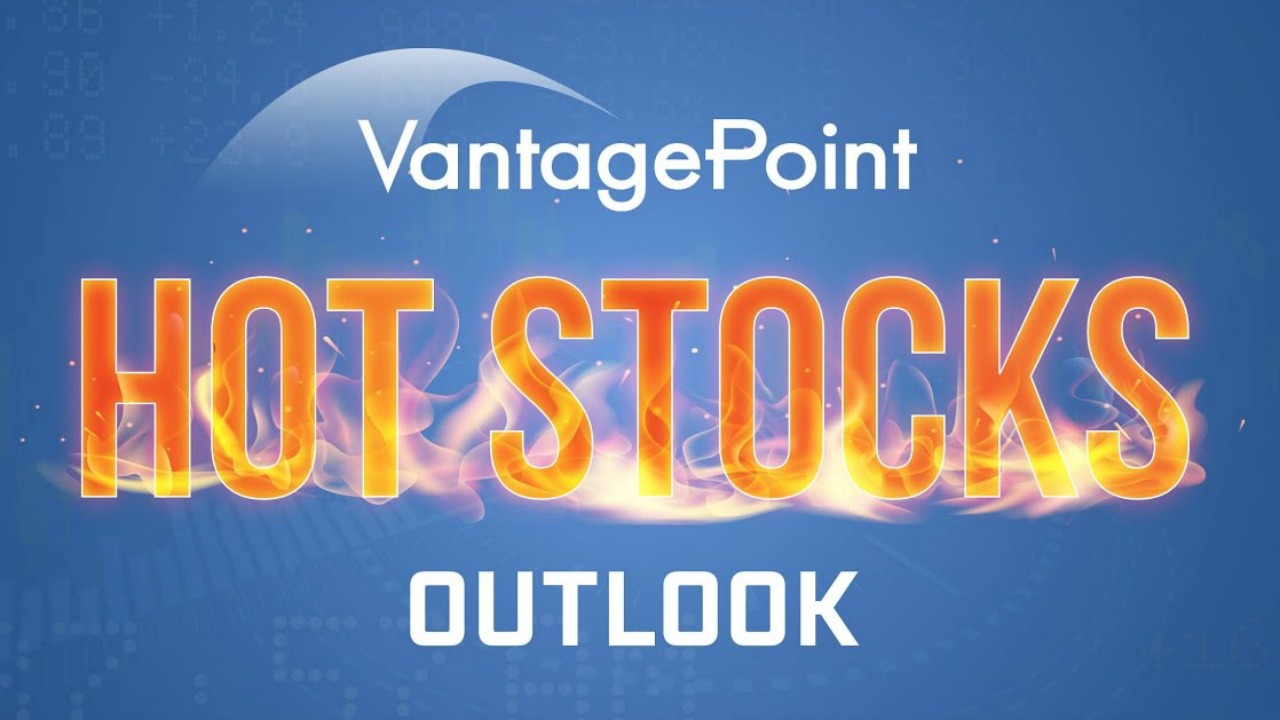| This Week’s a.i. Stock Spotlight is TESLA Motors ($TSLA) |

Tesla has been making waves in the auto industry, led by the charismatic and visionary CEO Elon Musk. Since June 2014, Tesla’s stock has skyrocketed by an impressive 1,050%, vastly outperforming the Nasdaq Composite Index, despite a recent pullback of 56% from its peak. This indicates a rollercoaster journey for investors who’ve hitched a ride on Tesla’s high-octane stock.
Currently, Tesla’s bread and butter is its car sales, which generate 85% of its whopping $97 billion revenue. The company has a robust lineup of five models, with plans to expand. Looking ahead, it’s clear Tesla isn’t swerving from its path of designing, manufacturing, and selling vehicles globally.
However, the road forward isn’t without bumps. Growth is expected to downshift, thanks to stiff competition and economic headwinds, forcing Tesla to slash prices to fuel demand. The next decade may not mirror the explosive growth of the past.
Yet, there are believers like Cathie Wood from ARK Invest who see a transformative future for Tesla. Wood envisions a lucrative robotaxi industry, potentially raking in $8 to $10 trillion annually by 2030, with Tesla at the forefront, capitalizing on its advanced artificial intelligence for autonomous driving. This audacious projection paints a future where Tesla could dominate a driverless taxi market.
Despite these grand visions, there’s plenty of skepticism. Musk has repeatedly delayed this futuristic tech, raising questions about its viability amidst technical hurdles and regulatory challenges.
If Tesla does manage to roll out a global fleet of robotaxis, we could see its stock soar once again. But let’s face it—the odds are challenging, and betting on such an outcome carries considerable risk. Tesla’s journey continues to be one of high risk and potentially high reward.
The most pressing questions traders and investors are asking about Tesla ($TSLA) at present include:
1. **How is Tesla navigating the increasing competition in the electric vehicle (EV) market?**
2. **What are the implications of recent regulatory challenges on Tesla’s operations and growth?**
3. **How is Tesla managing supply chain disruptions, particularly with regard to battery production?**
4. **What are the expectations for Tesla’s financial performance in the upcoming quarters?**
5. **How is Tesla expanding its footprint in renewable energy and autonomous driving technologies?**
The answers to these questions are challenging to say the least. What traders and analysts are doing is pouring over $TSLA’s financials and earnings calls to see if they can uncover any breadcrumbs to help put the puzzle together.
Over the last 5 years $TSLA has increased revenue exponentially.
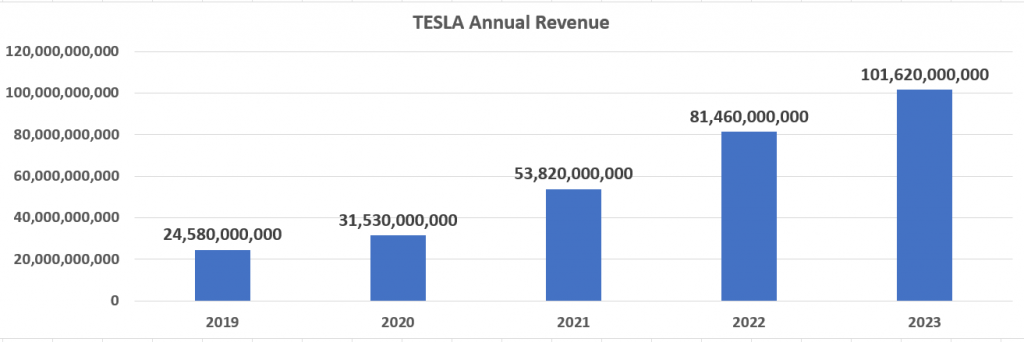
Earnings have also followed suit.
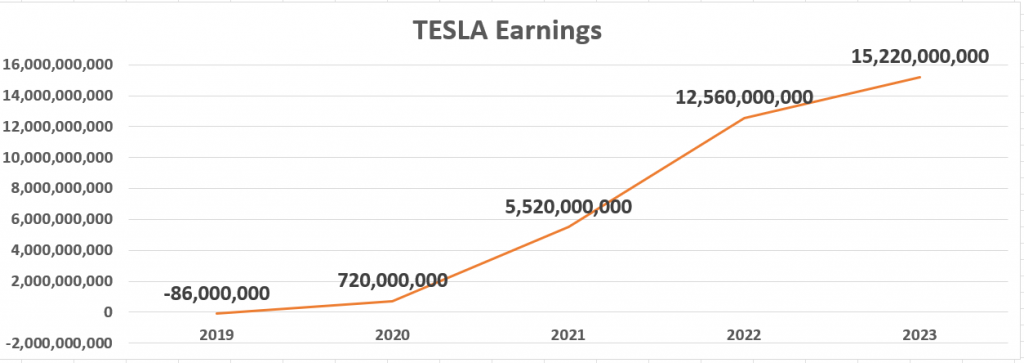
Over the past few months Tesla has faced increasing scrutiny from regulators in multiple countries regarding safety and driver-assistance technologies. This has raised concerns about potential fines and the need for significant adjustments to their Autopilot system. With new EV models entering the market from traditional automakers and startups alike, Tesla is experiencing heightened competition. This has prompted the company to innovate and potentially adjust pricing strategies to maintain its market share.
Global supply chain disruptions, particularly in semiconductor availability and battery components, have impacted Tesla’s production timelines. However, Tesla’s proactive measures in securing long-term supply agreements are seen as a strategic move to mitigate these risks. Tesla’s recent earnings report highlighted robust growth in revenue and vehicle deliveries. However, concerns over rising operational costs and capital expenditures were also noted by analysts.
Tesla’s push into renewable energy solutions, including solar energy and energy storage products, continues to grow, offering promising new revenue streams.
Over the past month, the stock has soared by about 30%, a sign of renewed investor confidence. This rally comes just ahead of Tesla’s anticipated second-quarter EV delivery report. Despite lowered estimates, investors are feeling optimistic thanks to robust delivery data from Chinese EV makers.
The Chinese EV market is vital for Tesla, especially with its highly productive Shanghai factory. Today, several Chinese EV companies reported strong delivery numbers for June and the second quarter, setting a positive tone for Tesla’s upcoming report.
Companies like Nio, Li Auto, XPeng, and the industry giant BYD all showed impressive year-over-year growth in battery-electric vehicle (BEV) sales. Notably, Nio hit a monthly record by delivering 21,209 vehicles in June, nearly double its June 2023 figures.
BYD, whose BEV sales volumes are comparable to Tesla’s, sold over 426,000 fully electric vehicles in the second quarter, marking a 21% increase year-over-year.
Analysts have been tempering their expectations for Tesla’s second-quarter sales, with the latest projections averaging around 420,000 EVs, down from approximately 466,000 in the same period last year. This would mark the second consecutive quarter where BYD outpaced Tesla as the world’s largest EV seller.
With signs of recovery in China’s EV market, Tesla could potentially exceed these conservative estimates. However, investors should keep a close eye on Tesla’s profit margins in its full second-quarter financial report. If sales boosts are driven by price cuts, the current surge in share price may be short-lived.
Tesla’s next earnings call is on July 23, 2024. Earnings are the key driver here.
In this weekly stock study, we will look at an analysis of the following indicators and metrics which are our guidelines which dictate our behavior in deciding whether to buy, sell or stand aside on a particular stock.
- Wall Street Analysts Ratings and Forecasts
- 52 week high and low boundaries
- Vantagepoint A.I. Forecast (Predictive Blue Line)
- Neural Network Forecast (Machine Learning)
- VantagePoint A.I. Daily Range Forecast
- Intermarket Analysis
- Our Suggestion
While we make all our decisions based upon the artificial intelligence forecasts, we do look at the fundamentals briefly, just to understand the financial landscape that $TSLA is operating in.
Wall Street Analysts Forecasts
Based on 34 Wall Street analysts offering 12-month price targets for Tesla in the last 3 months. The average price target is $182.82 with a high forecast of $310.00 and a low forecast of $22.86. The average price target represents a -20.95% change from the last price of $231.26.

This level of divergence of perspective on the company from Wall Street Analysts tells us as traders that massive volatility is baked into the price action for $TSLA. We always advise traders to pay close attention to the most bullish and most bearish forecasts and compare this quantity to the current price.
We have been tracking $TSLA for many years and 124% expected volatility is the highest that we can ever recall.
52 Week High and Low Boundaries
Over the past year, Tesla’s stock (TSLA) reached a 52-week high of $299.29 on July 19, 2023, and a 52-week low of $138.80 on April 22, 2024.

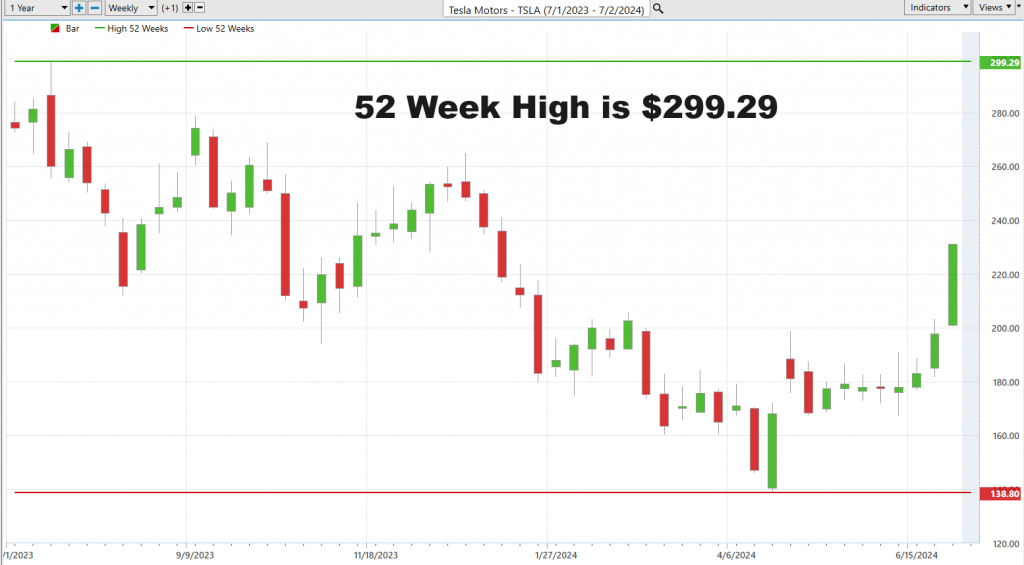
Let’s zero in on the rollercoaster ride that is TESLA stock ($TSLA) over the past year. This powerhouse hit a high of $299.29 and dipped to a low of $138.80 — that’s a swing of $160.49. Cracking into these figures, we see TESLA ($TSLA) has shown a historic annual volatility of 69%. What’s the takeaway here? It tells us loud and clear that swings of about 69% up or down are totally on the table for TESLA ($TSLA) in the coming year.
But here’s where it gets spicy: TESLA ($TSLA) is trading at the 57th percentile of its 52-week range. That’s right, at the middle of its game.
The 52-week boundaries of a stock are similar to a report card. We can quickly see the momentum and growth that a stock has mustered over the previous year. More importantly we can get a glimpse of how a stock has reacted when it approached these important boundaries. When we zoom out and look at the 10-year chart we can easily see how the past year compares to the previous decade.
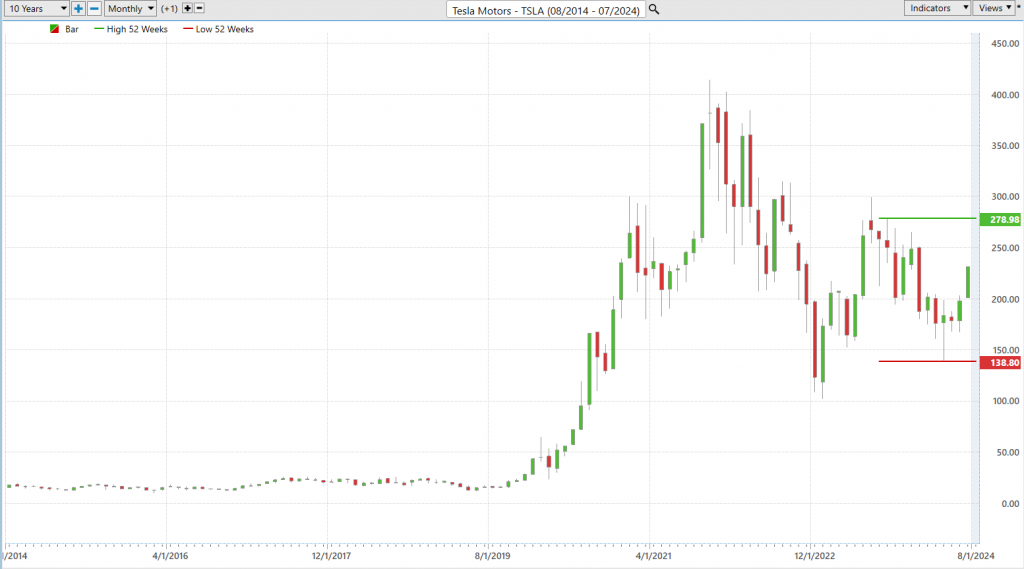
Best-Case/ Worst-Case Scenario
Let’s break down an indispensable tool for every sharp investor and trader—grasping the critical balance between risk and reward. This isn’t about tangled strategies; it’s about clear-cut analysis that reveals the stark realities of the best and worst outcomes. Picture this: we’re mapping out the high points and low points of market movements over the past year, like a captain steering through a wild ocean storm. This is your secret weapon to understanding the true nature of risk and reward in the gritty world of market volatility.
Envision this: we’re linking up the most powerful surges and sharp falls, similar to charting the rise and fall of ocean waves. This goes beyond mere market lingo; this is about diving deep into the essence of risk and reward with TESLA. By engaging in this straightforward exercise, you can swiftly decode the scenarios of highest gain and deepest loss.
Here’s what it boils down to: we must meticulously weigh those bullish surges against the bearish drops. It’s akin to navigating through rough seas, where recognizing the risks and volatility becomes crucial. But this isn’t just some clever trick; it’s about adopting a battle-tested mindset. By dissecting both the peaks and troughs, we unlock a full understanding of what a stock is capable of. It’s not just about predicting future profits; it’s about confronting the harsh realities of risk head-on. This method guides us through the chaotic waters of market shifts, exposing the real dynamics at play.
So, don’t just glance over those charts; dig into them. This is more than tactics; it’s about developing a solid strategy that enables you to make informed decisions, manage your risks, and build an investment portfolio that can stand up to any challenge.
Let’s get into the thick of it. From this perspective, we can quickly see the potential upsides and pitfalls of the past year for TESLA.
First off we study the Best-Case Scenario which entails buying at the bottoms and selling at the tops. While this is unrealistic, we simply want to measure the strength of the rallies.
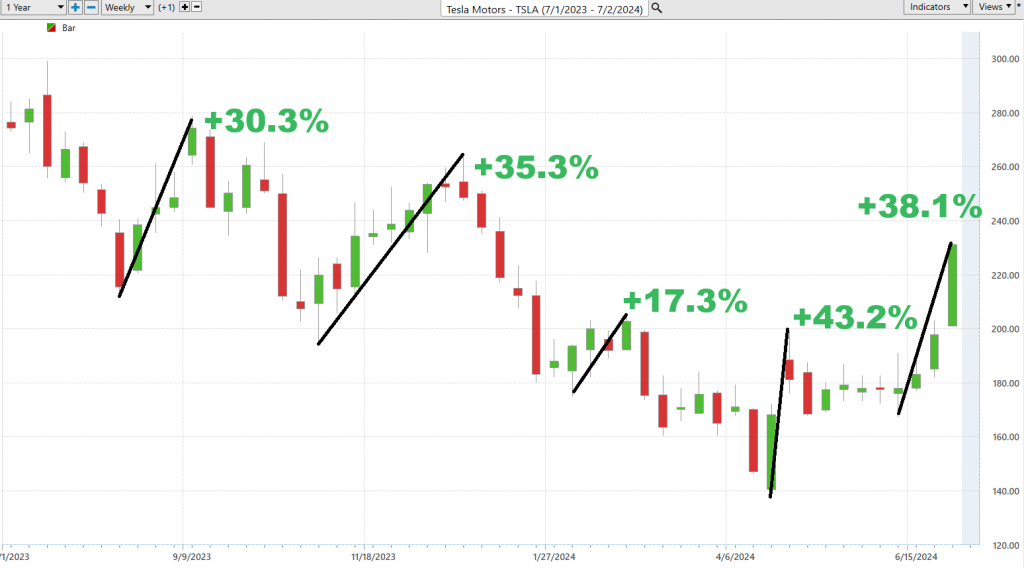
Followed by the Worst-Case scenario which entails buying at the tops and selling at the bottoms. The purpose of this simple exercise is to measure the magnitude of the declines.
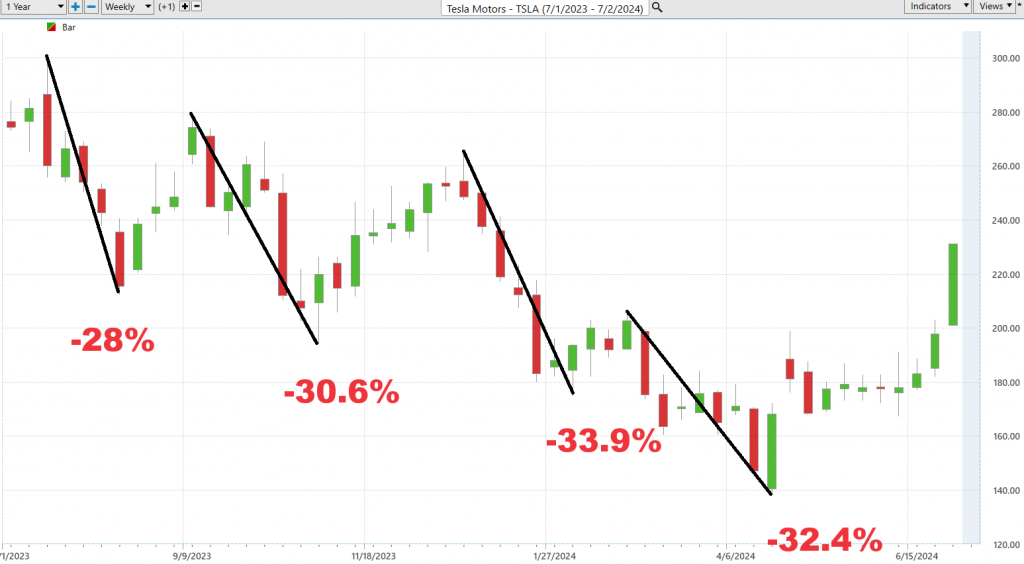
By completing this simple exercise, we immediately understand the level of volatility that has existed in $TSLA over the past year. This allows us to form a practical perspective and understanding that should the future mirror the recent past we can expect this type of volatility to continue moving forward.
Next we compare $TSLA to broader stock market indexes to understand its correlations and performance. $TSLA in a component of the S&P 500, The NASDAQ, and the Dow Jones Industrials.

Over the very short-term time frames $TSLA has outperformed. Over the longer-term time frames it has massively underperformed.
Lastly, to get even more granular we can compare $TSLA in comparison to its domestic competitors.

This competitor analysis shows that $GM and $FSR are clearly outperforming $TSLA. But once again $TSLA over the short-term time frames wins handily.
Vantagepoint A.I. Predictive Blue Line
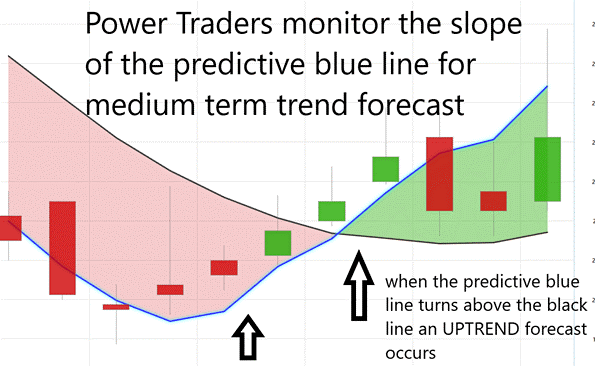
The core principles guiding traders in their dealings with TESLA ($TSLA) stock revolve around utilizing advanced tools for predictive trend analysis. The “predictive blue line,” a key tool offered by VantagePoint, provides insights into future market movements. When this line indicates an upward trend, it suggests a potential rally, prompting traders to consider buying. Conversely, a downward trend signals possible price drops, advising caution or a defensive strategy like hedging.
Around the predictive blue line is the ‘Value Zone,’ where traders strategically buy or sell based on the line’s position relative to stock price movements, aiming to maximize gains and minimize risks. The predictive blue line acts like a lighthouse, guiding traders through the complexities of stock fluctuations with the help of artificial intelligence. This tool isn’t just another chart feature; it’s akin to a financial GPS, offering real-time insights that are crucial for making informed trading decisions in today’s fast-paced market.
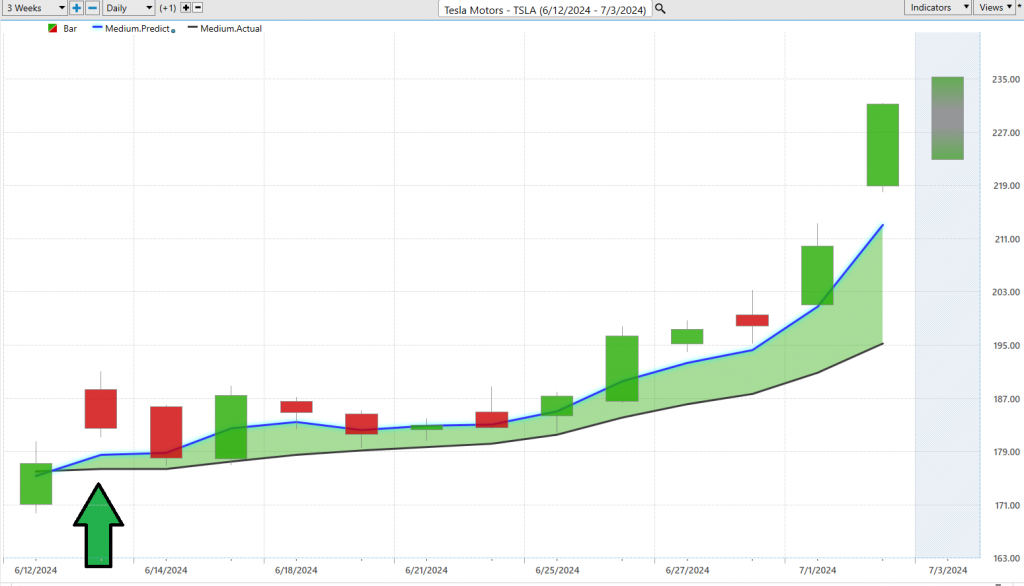
When you study the chart above, look at how the predictive bleu line acts like a “value zone” enticing swing traders to purchase at or below its level.
VantagePoint A.I. Neural Index Forecast (Machine Learning)
A neural network is like a super-smart robot that acts a lot like the human brain, especially when it comes to trading in the stock market. It’s a tool that helps traders by recognizing patterns and solving problems fast by looking at heaps of information all at once. Imagine it as a high-tech helper that can spot trends and odd things in the market that are hard for people to see. This is super helpful for traders because it helps them predict what might happen next in the market, like if stock prices are going to go up or down.
Neural networks are amazing because they can make these predictions quickly and accurately, which is a game changer in the fast-moving world of trading where every second counts. They’re like unbiased advisors, making decisions based on facts and data, not feelings, which means they can help traders stay cool and make smart moves. Plus, these networks keep getting better over time, learning from new data, and adjusting to changes in the market, making them an invaluable tool for traders looking to step up their game and make better trading decisions. When the Neural Index is green it indicates a bullish sentiment for the next 48 – 72 hours. When it turns red it communicates the inverse. Observe how the Neural Index anticipates short-term price movements very effectively.
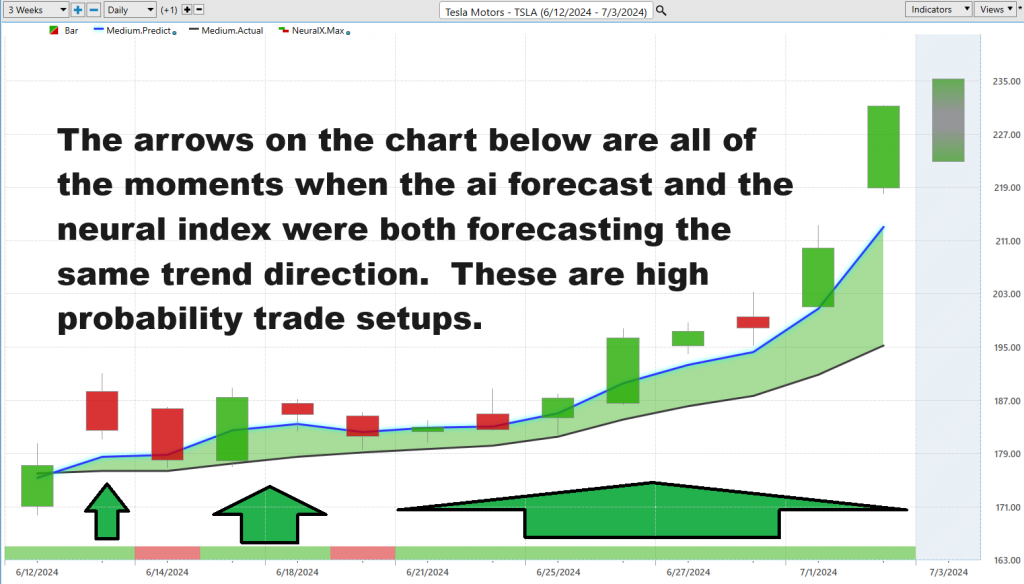
This isn’t merely progress; it’s a transformation, catapulting trading strategies into an entirely new stratosphere. For traders keen on leveraging the forefront of technology to master the markets, neural networks are crucial. They’re not just altering the game—they’re crafting entirely new rules.
VantagePoint A.I. Daily Range Forecast
Let’s tackle one of the most formidable challenges in trading—discerning precisely when to make your move or when to exit the fray. The whims of market volatility can confound even the seasoned trader, complicating these critical decisions. For those keeping a keen eye on stocks like Tesla ($TSLA), mastering the timing is all about understanding the subtle fluctuations across daily, weekly, and monthly trading ranges—and adeptly applying that knowledge.
But let’s cut to the chase: it’s not merely about possessing the data; it’s fundamentally about transforming that data into victorious strategies. Enter the formidable arsenal of A.I., machine learning, and neural networks. These aren’t merely trendy technical jargon—they serve as your navigational chart through the turbulent waters of the financial markets. They offer crystal-clear, actionable insights into market trends and precisely delineate trading ranges with astonishing accuracy, dramatically reducing the guesswork involved in your trading decisions.
Now, let’s examine the volatility that has characterized Tesla ($TSLA) over the past year, detailed by daily, weekly, and monthly time frames. This type of intelligence can significantly sharpen your trading acumen.

Amidst the prevailing market volatility, the VantagePoint A.I. Daily Range Forecast emerges as a crucial tool for traders. With its unmatched accuracy and thorough analysis, this technology grants short-term swing traders a distinct advantage, empowering them to navigate the market with renewed confidence. The tool provides detailed predictions of daily market movements, clearly defining market trends and expected trading ranges.
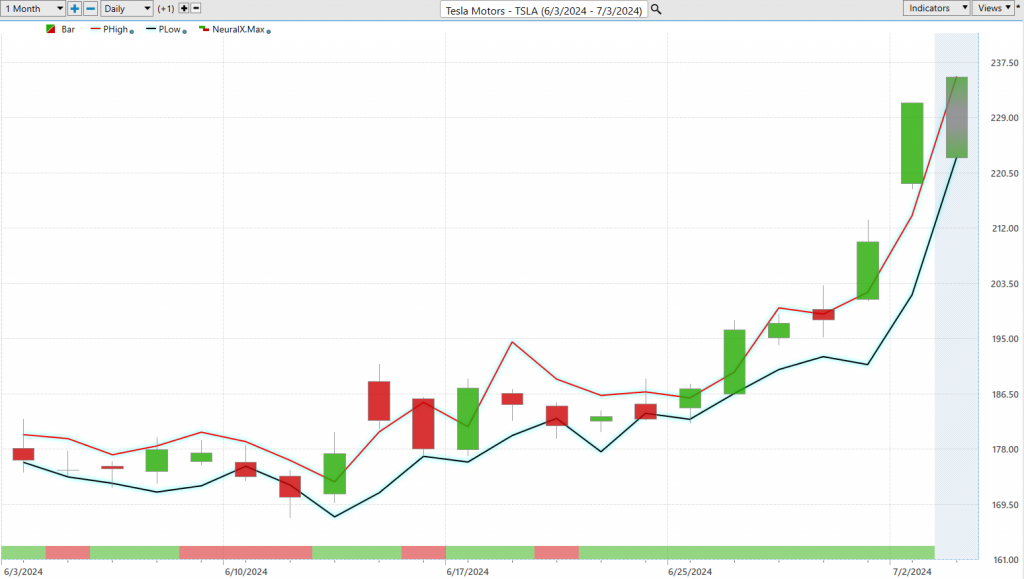
This level of detail enables traders to meticulously craft their entry and exit strategies, greatly enhancing their confidence. Leveraging advanced analytics, traders are able to transform intricate market data into practical, actionable strategies, setting the stage for significant growth even in the most unpredictable financial climates. The precision offered by predictive analytics is indispensable for traders eager to leverage market dynamics, underscoring the pivotal role of advanced technological tools in contemporary trading.
Intermarket Analysis
Intermarket analysis is a strategic trading approach that leverages the correlations between different financial markets, such as stocks, bonds, commodities, and currencies, to forecast price movements and enhance trading decisions. By examining the interplay between various asset classes, traders can uncover broader market trends, pinpoint potential turning points, and craft more robust trading strategies. Pioneered by figures like John Murphy, who illustrated these relationships in “Intermarket Technical Analysis,” and Lou Mendelsohn, who integrated this concept into VantagePoint software, this method has become a critical tool for traders. It allows them to anticipate market shifts based on a comprehensive analysis of factors including interest rates, economic indicators, and geopolitical events, thereby increasing their ability to spot undervalued opportunities and boost profitability.
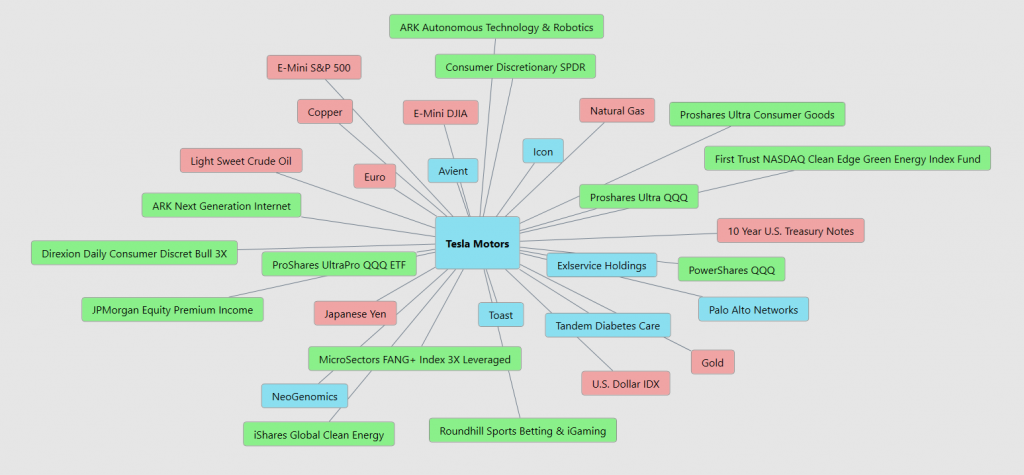
Intermarket analysis is a game-changer for Tesla traders, offering a panoramic view of how interconnected markets like stocks, bonds, commodities, and currencies can influence Tesla’s stock moves. By keeping an eye on factors like commodity prices for crucial battery components or broader tech sector trends, traders can pinpoint optimal moments to make their moves, manage risks more effectively, and even capitalize on shifts in energy prices that affect electric vehicle appeal. This method doesn’t just look at Tesla in isolation but considers a whole spectrum of economic indicators and market dynamics, arming traders with the insight to navigate the market’s waves with precision and confidence.
Our Suggestion
As this stock analysis was being written Tesla reported its second-quarter vehicle production and delivery numbers for 2024, with 410,831 vehicles produced and 443,956 delivered, surpassing Wall Street’s expectations of 439,000 deliveries. Despite beating estimates, the delivery figures represent a 4.8% decline from the previous year’s second quarter, but a 14.8% increase from the first quarter of 2024. Tesla’s stock surged by 10% following the announcement, even though it’s still down about 7% for the year. The decline in deliveries compared to the previous year was attributed to factors such as temporary factory shutdowns due to an alleged arson attack in Germany and shipping delays caused by conflicts in the Red Sea.
We think TESLA ($TSLA) deserves to be on your trading radar because of its volatility and because of how effective the ai forecasts have been. If you have paid attention to TESLA for any period you will quickly recognize that the stock is incredibly volatile, and we expect this to continue moving forward. Highly volatile assets are where the VantagePoint A.I. software shines.
As Tesla concludes its annual meeting, the focus now shifts to the firm’s second-quarter earnings, set to be unveiled on July 23. Additionally, anticipation is building for the grand reveal of Tesla’s robotaxi, slated for August 8. This marks a pivotal moment for the electric vehicle giant as it steers into potentially transformative new territories.
Our suggestion is to monitor the daily range forecast for short-term positioning opportunities.
Practice good money management on all of your trades.
Let’s Be Careful Out There.
It’s Not Magic.
It’s Machine Learning.
Disclaimer: THERE IS A HIGH DEGREE OF RISK INVOLVED IN TRADING. IT IS NOT PRUDENT OR ADVISABLE TO MAKE TRADING DECISIONS THAT ARE BEYOND YOUR FINANCIAL MEANS OR INVOLVE TRADING CAPITAL THAT YOU ARE NOT WILLING AND CAPABLE OF LOSING.
VANTAGEPOINT’S MARKETING CAMPAIGNS, OF ANY KIND, DO NOT CONSTITUTE TRADING ADVICE OR AN ENDORSEMENT OR RECOMMENDATION BY VANTAGEPOINT AI OR ANY ASSOCIATED AFFILIATES OF ANY TRADING METHODS, PROGRAMS, SYSTEMS OR ROUTINES. VANTAGEPOINT’S PERSONNEL ARE NOT LICENSED BROKERS OR ADVISORS AND DO NOT OFFER TRADING ADVICE.








